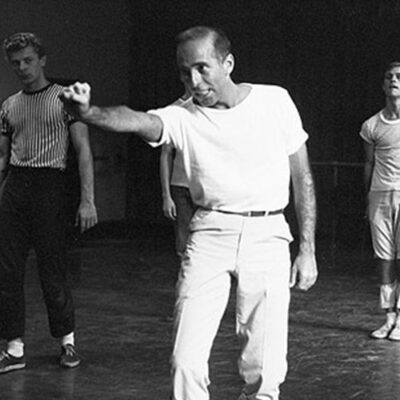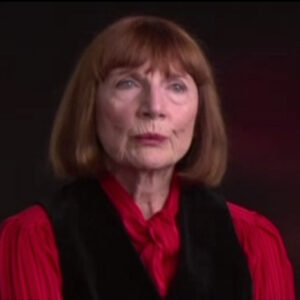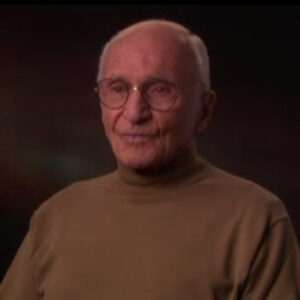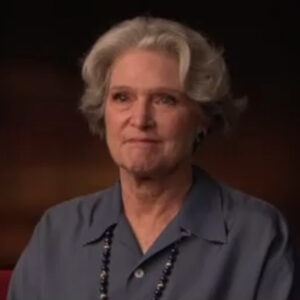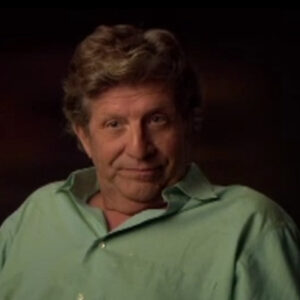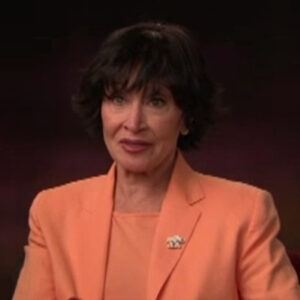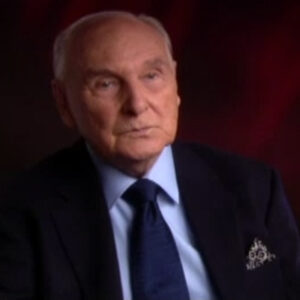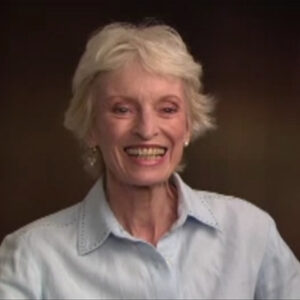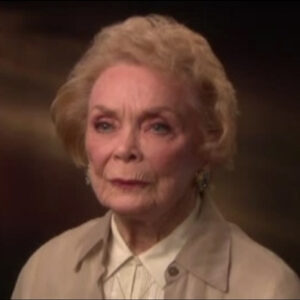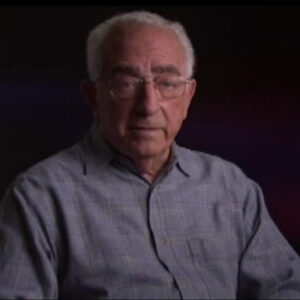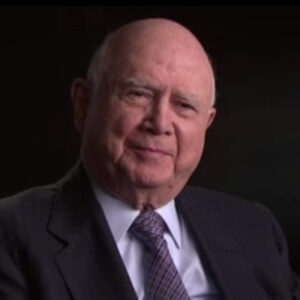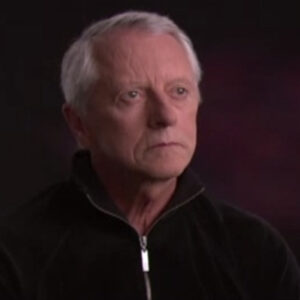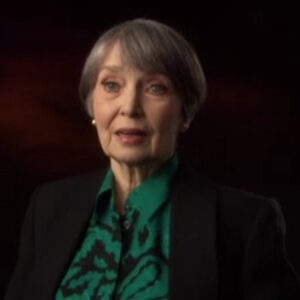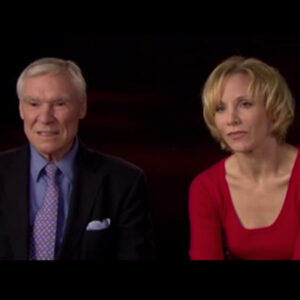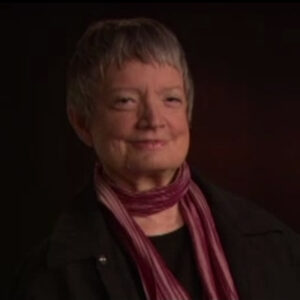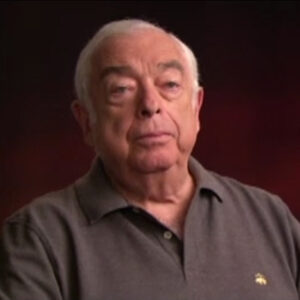Speaker So if I’m correct, the first ballet that Cherry made from you was in G Major, but he didn’t make it on you. Tell me how that worked.
Speaker He didn’t make any major on me and. I was somewhat uncomfortable with the fact that he had been using other dancers, I didn’t know Jerry’s work ethic the way he put ballets together because I was absent from the company when Jerry came in and I had heard stories about he likes to go all day long and he has ABCDE, PFG versions and things. So I had heard that we were going to do this ballet and I was somewhat confused when I saw other people’s name on the on the board for the for the ballet. And I thought, well maybe I’m not going to be in it after all. So I watched. And then one day he put Peter and I in and I of course love the music and love the choreography. It was my very first Jerry Ballet and I think it became a different ballet when it was Peter and I, because I think it became a different ballet because for one thing, Peter and I were taller than the people he had originally worked on it with. And that added a different dynamic when there was a lift. It would be a higher lift because of our physique. And I think it sort of took on a different kind of look about it. And he sort of worked that into the rest of the the ballet. I have one little story. I loved working with Jerry. I always had a good time with him. We. We’re comfortable with each other and I don’t know where I got the nerve, but at the end of the first movement of the belly, which is very energetic, Jerry couldn’t decide what he wanted me to wear. And it was practice, close format, simple costumes, but he couldn’t decide what color.
Speaker So I had on, I think, a white leotard, but I had several, maybe four or five different wraparound skirts and I put all of them on. And at the end of the movement, there’s eight cords. Da da da da da da da da. And I took them off with each cord. Da da da da da da da da. This was a dress rehearsal, you know, and and Jerry was a good sport about it. He laughed and he decided he said, Suzanne, I think it’ll be white, but I wanted to give him all those options off of skirts. I guess it was sort of also just to. Release some of the feelings and the nerves of having a premiere that night, but, oh, we had a good, good joke about that.
Speaker But I really loved and particularly the Partida was terribly moving and beautiful and had a wonderful time doing it. And Jerry likes to change things a lot. But after that first performance, he, to my knowledge, never changed that movement.
Speaker Tell me about the.
Speaker The Partita is so very special, it starts out with a piano and I love dancing to a piano, very simple. We just walk, I walk to the man, I’m facing him on a diagonal. Oh, most of my dance life has been on a diagonal and there’s no real story. But there’s very definitely a mood, a loving kind of mood and walking towards Peter in this case. And then I walk back and he comes with me and then we separate again and then we come together. And just as we’re coming together, we avoid each other and start start a movement very, very simple, which Jerry did very well. And then it gets a little more intricate when the orchestra comes in and a little more full and and moving and goes into lifts and, oh, running backwards and upside down. And it was very different from Mr. B’s choreography for me. And I also hadn’t seen everything that Jerry had done up until that point. And when I came back to the company, I remember seeing Jerry in the hall and he said, Suzanne, you know, if there’s any of my ballets you’d like to dance, just, you know, feel free. I’d love to have you do them. And I said, Oh, thank you. Thank you. But. I was still happy to be coming back and working with Mr. B. So I didn’t see Jerry’s values with the idea that I would want to dance them yet. And then when things calmed down and I was back in my usual, you know, repertoire, I took a look at some of his ballets at the cage, which I thought I always thought was a great ballet. And I asked him if I could do that. And he said yes. And then I was during the summer listening to some music on my island, doing a bar. And I had a recording of Ashkenazy play all those Chopin Etudes and the Jerry used. And I said, Oh, this music is so wonderful, I just have to dance to this music. So I asked Jerry if I could do dances at a gathering and he said yes. So, you know, we had a we had a good time together, but that’s different than when something is done for you.
Speaker And how did the moment for you on that while we’re still in G Major, you said that the it was very different from anything that you danced with. How is it different?
Speaker I suppose the part of the energy measure was different because. Jerry could be very specific about what he wanted, and that was an entirely different way of working with Mr. B.. You could you could bring a lot of yourself to it. And in fact, the whole with Mr. B, the whole ballet became part of you, how you moved. And I wasn’t quite. In the beginning, I think comfortable with Jerry, sort of. Oh, how should I say? Passive, you know, Mark, he would say Mark in places he liked it to be an easy energy in many things, but the full energy that that is should encompass. And so and also I didn’t have a history of knowing Jerry and feeling comfortable and working. So I was, you know, trying very hard to do what he wanted. And we arrived at something. But I think just the work, the way his manner of working was different. It wasn’t difficult. It was just I didn’t have a history of knowing him and seeing him in the studio and seeing him choreograph.
Speaker How is that different, for example, in terms of their trust in dancers?
Speaker I think Gerry trusted me. I certainly trusted him. In fact, I trust anybody that I work with because I think you have to be that way. But I was new to him as well. And he wasn’t around in the days that I in the early 60s when I was doing all of my dancing. So there was very much of a learning kind of relationship aspect to how he worked and how how I was and. I think that probably added to some of the interest of the Partito also, we were to unknowns trying to come together in and make something known in this Ravell ballet. And I think that vulnerability added to the tenderness of the Partita.
Speaker Why do you think you didn’t have difficulties with juror juries, many other people?
Speaker I don’t know why I didn’t have difficulties with jury. He was always very sweet. We would sometimes, after a performance go to, oh, I think it was called Dimitri’s Restaurant on Columbus Avenue and eat together. He was very kind to me and very easy. I, I don’t know why.
Speaker Just in terms of comparison between March and thinking of them each in rehearsal, temperamentally, how are they different?
Speaker I guess temperamentally, Jerry and Mr. B were well, they were two entirely different people I in my whole years of working with Mr. B., I think I only heard him raise his voice twice. Jerry could be outspoken and I hear he could be mean, but he never was with me. I’m I’m not the kind of person that likes to argue, to get energy and to give me, you know, some kind of feelings of how I’m going to achieve this ballet or to raise my blood level to get me to a performance pitch or something. I’m very sensitive. And maybe that’s the same kind of sensitivity that Jerry also felt, even though he expressed it loudly and I would become very internal. I don’t like to argue it takes too much energy out of me. And maybe he sensed that in me. And, you know, I also I never compared Jerry to Mr. B. Even when we were working, maybe Jerry compared himself to Mr. B. But I never did. To me, he was Jerome Robbins. I had always wanted to be in West Side Story. You know, I always loved Gypsy. And actually when I retired, I called Gypsy. I called Jerry and asked him because they were doing a revival of Gypsy on Broadway. And I asked him if he would consider me doing the part. He said, well, Suzanne, that’s a nice idea, but I don’t own it anymore. I sold my rights. But so I you know, I like that aspect of Jerry. But he came from a different world, I think. And he was in the theater where you only know dancers for the run of the show. You don’t have that same kind of closeness as when you grow up in a company with Mr. B and and you mature and you take class together and you learn how you work and what works, what doesn’t, what you need to work on there, you know, and that’s where it happens in the studio where you learn about the dancers and the choreography. So I think. Gerri knew my name. A lot of dancers didn’t like the fact that Gerri would just call them you or dancers, and I can see where that might be somewhat annoying, but. Jerry was we just always had a very easy kind of work in the studio.
Speaker How about in terms of their security?
Speaker You know, I didn’t know much about Gerry because I came in later, I. Didn’t know anything about him being secure or insecure or Mr. B., of course, I wasn’t a choreographer having to compare myself to Mr. Balanchine so I can understand how anyone who choreographs would automatically feel exposed, but. I wanted to work with Jerry because he was different. There’s no point in working with someone who’s not going to bring something else out in you. So to me, I wanted Jerry. I didn’t want Jerry after Mr. Me. You know, in the sense of of filtered through what what Mr. P. said, you know, with any choreographer I work with, that’s I want I work they are the most important person in my life at that time and. That’s how that’s how it was, so I don’t know. He never seemed insecure when we were working.
Speaker What do you think of those versions we’re about?
Speaker Well, but I wasn’t there for all the versions, so I wasn’t there for all the versions. So I don’t know how many more hours he spent in the studio before he finally got to what he thought was maybe a workable part of the, um, actually damage our told us that Chiari, when he was making Major, he felt like you were evaluating him.
Speaker And so I’m wondering, where are you? And if so, what was your assessment?
Speaker I wasn’t evaluating Jerry at all. I, I would never do that because. If there was nothing for me to learn from Jerry, then I wouldn’t do a Jerry Ballet. I had a big repertoire. I was happy dancing. I chose to to do a Jerry Ballet and.
Speaker So I wasn’t evaluating and anyone why do you think he brought I the balance? I didn’t.
Speaker I don’t know what jury brought out in me that Balanchine didn’t. That’s a difficult question to answer. I suppose maybe it’s more obvious in the way the ballet ultimately looked. Um, I really don’t know at this point.
Speaker Um, I prayed once that you said about you choreographed his ballets in black and white and allowed the dancers to color their man. And I’m wondering how that compared with the way the Djerriwarrh.
Speaker I sense that Jerry probably did a lot of good.
Speaker I call kitchen choreography where you sort of dance around in your kitchen waiting to get to the studio to choreograph a ballet. I have no way of knowing this, but.
Speaker Mr. B really came into the studio only being familiar with the music, I don’t believe he really was testing out steps or trying anything in in the studio before or after anything. And I I remember sometimes going into the studio and seeing Jerry dancing around and trying things out. And I understand that because first of all, I think he it gave him a better sense of what he wanted, if it makes sense on your body, than you can maybe make sense into the person who’s going to interpret your your ballet, but. You know, it would look good on Jerry, but not necessarily good on me or someone else, and that was the biggest difference probably was that Mr. B. Wood would. Give you enough ocean to swim in for you to find where you could float and and Jerry was much more earthy and and exact about how he wanted it to be, there was less interpretation, less freedom to interpret, comparatively speaking. But that’s what makes Jerry Jerry. And that’s what makes Mr. B they’re both important.
Speaker We talked a little bit before about how beautiful the two major dwarves at Jerry’s really known for the wonderful, he’s made a whole bunch of wonderful duets. In your view, what’s so great about them?
Speaker I think I think his. Simplicity. You know, there’s nothing more complex than simplicity and.
Speaker And there’s a very specific relationship between the man and the woman in all of his partidos, whether they’re Forn or G Major or Dance’s together in the cage, there’s always a definite a strong. A male female presence, and they. They don’t support each other in the same way physically, the man has less of a porter or a consort in Jerry’s bellies. The man is more. His own self, and so you are two people, you know, in the same orbit, but you are separate planets and. And it gives them a very earthy quality, I think, and a very human quality. And Jerry was very. Intense and very real. And I think it’s mostly manifested in his part of this.
Speaker Since you were the reigning ballerina of your day, why do you think you can use your.
Speaker I don’t know why Jerry didn’t use me more. Well, we did other dances, Peter and I, and that was a big step, I think, for Jerry to have a tall cast do something that he had done for a smaller cast. And that probably was the one ballet where he gave us the most freedom to be our own size. And he would even change some of the steps slightly just because we were the dynamics were different. And I think. I hope the jury saw that. He doesn’t have to. He didn’t have to be as rigid all the time that he was he could be secure enough to know that his ballets could withstand the height, change things like that. And I enjoy doing that so much other dancers. But I think I forgot the question of the reigning ballerina of the time. Oh, with you when the results were great, I, I suppose perhaps Jerry didn’t and I didn’t do more ballets together because maybe Mr. B was getting older, Mr. B was getting ill.
Speaker Um.
Speaker I certainly wanted to continue doing all those things work with as close as I could with Mr. B.. Maybe he just didn’t have any idea that he wanted to see me. I don’t know.
Speaker I don’t know.
Speaker Do you think maybe he had some sense of you as balancing some of the balance, you know?
Speaker I suppose people have considered me Balanchine’s ballerina and thought.
Speaker I have to be remote or.
Speaker I can’t use her as often as I want something like that, I never felt that way, but I couldn’t speak for I can’t speak for anyone. But I was always happy to be working on something new. If it was possible.
Speaker Or I don’t know. Um.
Speaker You mentioned that you danced on your coach, Jerry never really coached me, and after none of a fun, I, of course, had memories of seeing Alegra do it when I was growing up and different people dancing it. And it was a heart wrenching, you know, breathtaking ballet. And so naturally, I wanted to do it.
Speaker And he said, fine and.
Speaker I think almost every young, every ballerina, every dancer knows whether they’ll ever get a chance to do it or not, because deep down you want to. But so there was very little to learn. I, I know that he.
Speaker Coach, just once. Primarily for Peter’s film that he did. I don’t know if you have any of that, but I think that was sort of a.
Speaker We had already performed it many times before that happened, so I don’t really know about it.
Speaker I don’t remember much about him coaching me in college either. I, I, I wasn’t as good as I hoped to be. But it is a great ballet. That doesn’t mean I’m going to be great in it. I just I just, I just I just wanted to dance coach because I again, it was always in the repertoire when I was in the young dancer in the company and I was somewhat shocked by it, the whole idea and the choreography. But at the same time, I was intrigued and wanted to do it because of that, for the same reasons. It was also Stravinsky. I had grown up on Stravinsky ballets and I thought it was a great piece of music. And when I see something wonderful, I just want to be able to experience it to I more than experience it. I want I want to be able to have that go through my body because music makes me want to dance and the different kind of movement and. I had come back from Europe and I was a different person, and I he said, Suzanne, if there’s any values you want to dance, just ask. So I looked at these ballets again and I said, you know, that’s just too good a ballet to not try. And that’s always been my my approach.
Speaker Well, OK, so speaking of going back and forth to Europe, May 22nd, 1969 was a big day at the New York City Ballet. And for you and for Jerry, you want to tell me what happened that day?
Speaker That day, well, yes, that was a. Some things are very clear in my mind, it’s not easy.
Speaker My version, which is the version, the only version that I know is that.
Speaker That was the premiere of dances that are gathering, and the program was to be dances that are gathering and symphony in C and I had always done second movement, symphony and C and was scheduled to do it that night as well.
Speaker And that was fine.
Speaker I hadn’t seen much of dancers at a gathering because I wasn’t involved, and then Eddie Villella said that he wanted to give all his energy to dancers at a gathering.
Speaker He was scheduled for Third Movement Symphony and C, and he asked not to dance.
Speaker So do we have to go into this? Tell me as much as you. I don’t mind. I just feel repetitive, you know, and that somebody else is going to say something opposite. So, you know, I just I get tired of talking about it, but I will I will say that.
Speaker I set out in the audience and watched dancers at a gathering and thought it was a wonderful ballet. It was such a surreal evening. I mean, I don’t know how I how Paul and I could sit in the audience and watch when we had just been fired, you know, but what do you do when your life is suddenly unreal?
Speaker You do.
Speaker You do what you’ve always done, you go to the theater, you know, the theater was always my solace. I would work when I was happy and I would work when I was sad.
Speaker So in between being happy and sad, I learned how to dance, you know, might your whole life is there and you feel safe there.
Speaker So we sat there and then I suppose there was a party afterwards.
Speaker It was a big gala, which we didn’t go to. We knew better than to go to that. But, uh. Up until that point, I hadn’t interacted much with Jerry and so.
Speaker But all I remember well, tell me your reaction, boy, tell me the audience reaction, what do you remember about the response to that? Is that.
Speaker I don’t remember much about the response it I thought it was a beautiful ballet, and I know the audience was very enthusiastic, but I, I, I couldn’t tell you exactly because I, I wasn’t myself at the time. Um, and, you know, Jerry didn’t hold anything like that against me when I did come back. We never talked about anything like that. You know, it’s it’s we came to a low point in our time. And in fact, I don’t I didn’t. I don’t to me, I don’t know Jerry until in G. Major.
Speaker So you went to Europe and when you go to Europe, I understand you were surprised to find out that actually Jerry was better known to Balanchine. Can you tell me can you give me what I remember?
Speaker Jerry was huge in in Europe. I remember going and seeing the movie West Side Story at a cinema in some city. I was performing in honor of night. Everybody knew Jerome Robbins. He was. They got over there as well. He should be, you know, and it’s fun to see other cultures embrace what he did, but and probably there were, I’m sure, all over Europe adaptations of West Side Story and all of his show. So he was he was everyone knew Jerome Robbins.
Speaker For the purposes of this discussion, we’re going to skip over Brussels and so it’s 1969 and you come back to the New York City Ballet. So just if you could tell me in a sense, what was the first ballet that you danced when you came about?
Speaker The first ballet I danced when I came back to the company was the ballet. I was supposed to dance the night I left in 1969, Symphony and C, although I think I had been slated for something else, Concerto Barocco. But I got a little under the weather and as it turned out, I did a symphony and see my first performance back in New York.
Speaker A little irony there. What was the first new ballet you danced with? You came back and if you could tell me the circumstances, it was in that it was in the context of the festival.
Speaker The rebel festival. The Ravell, first of all, was my first festival. There were many festivals that city ballet in my absence. Stravinsky and others. But this was my first experience of rehearsing all day, performing night crazy schedules, going from one studio to the next, no breaks, things like that. So I was baptized into the Ravell Festival, but the first ballet that I was asked to do was Bizshark and was Albarado del Grazioso, which was a part of that actually Paul and I had done in Europe together, choreographed it so well, I suppose. And I suppose that after Jerry saw that, Peter and I could do other dances and he had choreographed for Macia, you know, for a smaller couple. And then he saw that he. Lost nothing by having a toddler couple to it that he felt perhaps comfortable and doing a second version for four seasons and maybe even liked the fact that he could choreograph a couple other versions as he was wont to do. And so most of it was the same. The potato was the same. But but I like being.
Speaker So many of my roles were always the nice girl, and in the fall she’s a little bit, you know, seductive and it’s somewhat of a fallen celebration and wine and things, you know, as Jerry was interpreting the season, the festive of the harvest. And I thought it would be fun to really I even had a wild hairdo, you know, and put spit curls on. And, you know, I liked looking different than other ways that I was could be looked upon. And and I also think I’m just a bit of a ham. And there, like I said, I would have loved to have done a Broadway show. I, I pantomimed I saw more Broadway movies than I saw ballets and got Broadway. LPs and memorized the lyrics, so I knew Jerry before I knew Jerry and I would pantomimed them in my living room. And so to do something like Four Seasons was was the equivalent of me doing a robbins’ musical because it brought out that kind of theatrics and that kind of. Broadway, brasenose, you know, and.
Speaker And he was it was probably the most.
Speaker Oh.
Speaker He was the least hands on in that variation when he was doing something, because I think he was curious by now we had worked together and maybe he was curious to see how I could what I could do with it and I could do lots of turns and things, you know.
Speaker So he capitalized on that and I had great fun doing it.
Speaker It looks like so much fun, it’s lots of fun.
Speaker He wrote that he himself wrote that he had trouble choreographing large groups. Do you have any recollection of that within the context of four seasons?
Speaker I don’t know about Gerry feeling.
Speaker That large groups were a problem. I wasn’t in that many big ballets, so I wasn’t aware of that. He always he always seemed so in spite of the fact that he had so many versions of what he thought he wanted. He seemed very clear about what he wanted. He wasn’t always sure of.
Speaker It at the moment, but he had a specific plan in his mind, a specific look in his mind of how he wanted it. I believe to to touch us to be and. The steps. Came after that.
Speaker Now, sometime after a jury approached you about making you tell me, yes, I was shortly after Mr. Balanchine died, this I remember very clearly I was. At the water fountain, Jerry was coming up the back stairs in between rehearsals and he said, Suzanne, I have an idea about a ballet. Would you be interested in working with me?
Speaker And.
Speaker I was having hip problems at the time, this was 85.
Speaker My problem with my hip began in 83, so I had been dancing for quite a while with soroche enough on the. So I do and I feel people enough telling him this because.
Speaker I didn’t want to use up his energy and his time and promise him something if I couldn’t come through. I said, Jerry, I don’t know, I have a bad hip. I know you like to work long hours. I, I know that you like to try things and have several versions, and I just don’t know if I can give you everything you need.
Speaker Every day that you need it, but I promise you that I will do it if you can work under those constraints, that I would love to do another ballet with you. But I’m already compromised, you know, physically compromised. And I wasn’t quite sure what would happen, you know, because probably he wouldn’t want to use me.
Speaker But then, you know, he came back and said, OK, and.
Speaker Then I saw the rehearsal sheet and there would be somebody else’s name up there. And so, again, I couldn’t understand, you know, well, am I going to be in this ballet or not? Because I. Didn’t want to be a cipher, I wanted to be, you know, the person that he was working on.
Speaker Oh.
Speaker But he felt, I guess, more comfortable mapping it out on someone else and then bringing me in later, and in a sense, I guess that was a little bit easier. But but there were many movements that were not. Comfortable to me, not not physically, but just the way I move. So he would change things and that was fine. So, you know, a lot of what he had mapped out on someone else didn’t ultimately happen, but.
Speaker There was one funny day where we had been rehearsing already for quite a while and Jerry was cute, he came up to me and he said, Suzanne, how’s your hip? Isn’t it is your hip isn’t bothering you? And I said, Oh, yes, Jerry, I’m having a good day. We can continue working. I think it was sort of, you know, hoping that maybe, oh, we could terminate the rehearsal because he he wasn’t sure where he wanted to go. But, you know, I can’t remember if we left or what, but it was a we had a good rapport. Jerry and I. I felt comfortable joking with him and he felt comfortable. You know, we were very open and honest with each other about this state of mind in the.
Speaker I think the state of mind is the company and 85 at that time was. We were all still hopeful we had Jerry. You know, we didn’t have Mr. B, but we had his battles, we had Jerry. Jerry was enthusiastic.
Speaker Jerry was from time to time, would teach a class, which was fun, you know, and I think galvanized the company and united us somewhat in the absence of such a strong leader as Mr. B.. I, I hope it did. Jerry made him feel good that, you know, he was we needed him. So at least I felt I did and the company did, but.
Speaker We still you know, we’re hopeful, and as long as Jerry was doing something new, it it made us feel as though. It was it was easier to go on.
Speaker What do you think it says that he chose the quintessential Balanchine ballerina of the moment for ballet? That was really about Los.
Speaker I.
Speaker Was unaware of what this ballet would be called for a long time, it didn’t really have a name right away.
Speaker I don’t think Jerry knew what to call it right away.
Speaker I was surprised when a title went up on the bulletin board and of course, lots of whispers. And what does it mean? What does it mean? I guess everyone could interpret it the way they thought. I Jerry never mentioned anything to me about the title, but he did tell me the story about Mahler and. The niece, Alma Mahler of The Girl, my character, and how she was inflicted and died at a very young age, and I like the fact that he didn’t give me too much information, but he gave me enough information because he wasn’t doing the story of he was doing his own story. And I think as much about, you know, we all have love, we all have loss. We will all continue to have love and loss. And you can’t have one without the other. And a. And, you know, just getting back, I go off on tangents, but I remember standing in the wings with Mr. B and he would be watching dancers at a gathering, you know, and he thought it was a wonderful ballet. He would always come down and watch dancers. And I would hope that Jerry would have seen him there and understand, you know, why the appreciation and respect that Mr. Bush had for Jerry, but. I don’t and I’m sure some of it of in memory of was. Jerry lost Mr. B as well, you know, it was a big loss for him. I mean, Jerry grew up in New York City Ballet and then left and came back and was instrumental in tying City Ballet over four years. So, you know, it was a big loss from Jerry.
Speaker Did she ever tell you why he liked to dance together?
Speaker No, just showed up. Oh.
Speaker Jerry wrote in his journal after your first one in memory of.
Speaker That it was the most extraordinary or so I’m quoting him, the most extraordinary person ever had. It was as near an automatic writing as I’ve experienced, Suzanne, and I fused. What’s your recollection of it?
Speaker I I was really unaware of those feelings until I heard his journal, but I, I was just I felt so oh, I don’t know how I felt so humbled because I didn’t know you felt that way. Maybe he. Appreciated the fact that I was in such a difficult situation and they’re working anyway and by choice and happy to be there, but I think. Maybe that brought something out in the ballet as well. It’s not easy to choreograph for someone who’s losing their body and make it look real. But my problem sort of. Limited my movement. And so it may be fused the ballet in that sense because it eliminated a lot of choreography and I got it down just to the essence of what maybe Jerry wanted to say. I don’t know. I was just struggling to to do what he, you know, to to be at my best in rehearsals. I wasn’t. You know, looking at. I was unaware of those profound feelings that he was having, but I do know that one day I do feel I can’t say when, but there was a day when. I thought I think I’m going to make this it’s going to come together. Maybe that’s what he felt. Maybe it’s in retrospect, but, you know, I. I certainly got strong.
Speaker Not not so much physically, but I knew that this was going to happen, and I think Jerry did, too, because the other person wasn’t around, didn’t come anymore, you know, he particularly the Partida with Death with Adam, that was the most intense I had been in a long time and probably the most intense that Jerry had ever worked with me where it was really, really.
Speaker Specific, but it just sort of.
Speaker It was like Niagara Falls, it just poured out of him, it poured out of us, you know, it it was like it it just happened. And in a way, it was easy. You know, nothing is easy, but it was maybe it was, you know what he said? It just all sort of came together. But it was a very charging kind of time. What did he tell you? And he and he first he he almost he almost did that, I think, in one day. And it never changed the polidor with the death. Would you tell you which is rare?
Speaker What did you tell you about the two main characters? Did you delineate them for you in some way?
Speaker The two main characters, well, the first one, I think he suggested that it was sort of a young, youthful romance. And it was very sweet, very, very moving, but but he didn’t stay around for a long time.
Speaker And second.
Speaker Well, it’s it’s interesting to be in a ballet where you have two male partners in the sense not just partner, but a. In your life, in that in that ballet, and they were so entirely different, you don’t often get to have life and death in the same ballet. And so one of the boys represented life and the other partner represented death. And it’s not a long ballet. And I think it’s fascinating how concisely he he made it all happen within the music and the story. It’s it’s based on someone, but it still is an abstract story. But it’s a very powerful story.
Speaker And I strangely enough, I felt more alive in the death part of it than I did in the in the first part of it because it was so powerful.
Speaker I I don’t know what was going on with Jerry at the time, you know, something very reflective or strengthening to him to have such a.
Speaker Uh.
Speaker It is death, but it’s not sad, totally sad.
Speaker Um.
Speaker Could you tell me why it’s kind of touching, I think, to the Jerry choreographed ballet to music that was inspired by a girl who was infected with polio?
Speaker I don’t know why he chose that the music of Alban Berg, I have no idea why he was just inspired by the music.
Speaker I mean, he talks a lot about that.
Speaker See, I he speaks so well about it himself. I feel reluctant to add anything that.
Speaker Did during the course of the night, it was very complex music, and I’m grateful that Jerry figured out all the complexities. Not that I hadn’t done, you know, other difficult music before, but I hadn’t danced to that type of music that required to be someone to get a story across, to get a story of someone who has polio and not be maudlin or disingenuous. Our art form is not something that usually depicts infirmity.
Speaker So that was a big.
Speaker That was an interesting concept, but I understand that he liked the music very much and and maybe it was just something he had to let fall from him, that story, his own story. But he used this story to to let it fall away. A surrogate.
Speaker David talked to you about Tony never talked to me about any.
Speaker One critic wrote that in this in this particular valley, Jerry forced you to extend your range and undertake movements that had never been tried before.
Speaker That’s true.
Speaker So there are some passages in the dance with death where I’m practically walking on my knees or taking long strides on point with bent knees and being torn by death. You know, my arms are behind me.
Speaker And and really, it wasn’t painful, but it was enough uncomfortable to be real and to feel like you were. Being torn apart or that your your body was being taken from you, and so as a result, it was not difficult to have to do because it was in a sense, I feel the only movement that could be valid at that point in time symbolized just have places in the choreography where there could be no other movement. It’s just there’s only one movement. And it’s what it is. And then there were places where I would be upside down. I had certainly been on the floor before and Bellows is my past, but I had never been pulled across the stage. The way, you know, Partidos don’t usually end that way. I love doing it, but. It certainly was not the ballerina role in that sense, but. And Adam was wonderful in it, and it was a it was a wonderful ballet. Strange in places, I went back and looked at it again a couple of months ago, there are passages that I don’t even remember, but the Partita with death mostly is still. So I if I had to do it, I could. It’s just so etched in me.
Speaker Before we leave in memory, is there anything else that you recall about for being willing to say about?
Speaker Then I can think of. What did you learn from Jerry?
Speaker I learned from Jerry.
Speaker How to work with different sensibilities. How?
Speaker How you have to draw on other resources or give yourself over differently to another choreographer, which I always did, but.
Speaker In a way, you can’t get any more different than Jerry and Mr. B and.
Speaker Well, and very heard music differently. I was very in tune to Mr. B. I think I heard the music the way Mr. B wanted it to be heard when he was choreographing and with Jerry, Jerry heard the music in a way that it had resonance and affirmation and validity to Jerry.
Speaker And he didn’t have to make it that comfortable for me because. Even though I would be interpreting his ballet.
Speaker He didn’t want that is perhaps certainly in in memory of you don’t want to be second guessing what the choreographer was going to do, you know, sometimes when you work with somebody and you are very comfortable with them, you sort of fall into things or there’s a, you know, give and take. And he says, well, fill in here. You know, something Jerry wasn’t wasn’t like that. And so I didn’t have that latitude. So it’s not that I was reined in or unleashed in Mr. Bush’s allies and reined in and Jerry’s it’s just they have they want a different outcome and they have a different way of saying what they want to say. And as a performer, I find that interesting.
Speaker You know, I want to be many, many different facets. I. I don’t feel you you never lose yourself when you become another facet of what you are. It just adds to your your.
Speaker You’re who you are instead of taking away from who you are. A lot of performers are reluctant to. To be that kind of a material, they have very different ideas of how they want to look, how they’re comfortable, how they look best, what are what profile, you know, performers.
Speaker You sit in your dressing room and you put on makeup every day and you know your profile, you know how your makeup should be. People in films, they have their better side. They only have light from certain, you know, the camera angles, everything, you know.
Speaker But, uh, so you you know, your body, you know yourself, but sometimes you don’t know your best self if you always feel you have to look a certain way. So Jerry liked, I think, that latitude of having someone.
Speaker Be willing to be different.
Speaker But that at the end of the first four years of in memory of. I don’t know if you’ll remember this, the first one through the company applied and that had never happened to him before.
Speaker Do you remember that first rehearsal live in memory of the first run through on stage?
Speaker I have been in the house hall, but I was going to ask you this. You know what? In the context of the company’s loss and what you have to leave and what did that.
Speaker I don’t remember.
Speaker OK, um, is there anything else that you would like to tell me about Jerry? Um, I haven’t asked you.
Speaker And in the later years when I was at a group together, I asked Jerry if he would allow my dancers, me, my group to perform afternoon of a afan. I had wanted to put on a program of ballets from Masters of the 20th century. And I considered Jerry to be in there, you know, and he I told him it was through the Education Department and that there wasn’t a lot of money being made or anything. And he said, well, let me yes, I I’m perfectly happy with you doing that. He said, I need a little information, you know, who are you going to use? And I said, well, I you know, it’s a young person, you know, and I. You trusted me performing the ballet, I would hope that you trusted me with who I chose and. And he said, OK. And then I said, and there’s one other thing, Jerry. Can we do it without the scenery? Which, of course, is so stunning, but we didn’t have a budget to do it without the scenery. And he never let it be performed without the scenery. And he was very kind. He let us do it without the scenery. So those are very generous, you know, aspects of Jerry that aren’t always known by people. And we wrote a few letters over the years just you know, I wrote a letter saying how nice it was to see him at Danilov as a memorial at the library and that I was sorry I didn’t get to talk to him longer because it was there where he has all his collection, you know, at the library. And he wrote a nice letter back saying, yes, but isn’t it sad how few people came? So Jerry and I had these little, you know, letters that, you know, we exchanged very human, very kind and very supportive.

